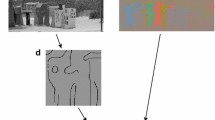Abstract
Still, much of computer vision is predicated on greyscale imagery. There are good reasons for this. For much of the development of computer vision greyscale images were all that was available and so techniques were developed for that medium. Equally, if a problem can be solved in greyscale - and many can be - then the added complexity of starting with 3 image planes as oppose to 1 is not needed. But, truthfully, colour is not used ubiquitously as there are some important concepts that need to be understood if colour is to be used correctly. In this chapter I summarise the basic model of colour image formation which teaches that the colours recorded by a camera depend equally on the colour of the prevailing light and the colour of objects in the scene. Building on this, some of the fundamental ideas of colorimetry are discussed in the context of colour correction: the process whereby acquired camera RGBs are mapped to the actual RGBs used to drive a display. Then, we discuss how we can remove colour bias due to illumination. Two methods are presented: we can solve for the colour of the light (colour constancy) or remove it through algebraic manipulation (illuminant invariance). Either approach is necessary if colour is to be used as a descriptor for problems such as recognition and tracking. The chapter also touches on aspects of human perception.
Access this chapter
Tax calculation will be finalised at checkout
Purchases are for personal use only
Preview
Unable to display preview. Download preview PDF.
Similar content being viewed by others
References
Barnard, K., Martin, L., Funt, B., Coath, A.: A data set for color research. Color Research and Application 27(3), 147–151 (2002), http://dx.doi.org/10.1002/col.10049 , doi:10.1002/col.10049
Bianco, S., Schettini, R.: Color constancy using faces. In: CVPR, pp. 65–72 (2012)
Borges, C.: Trichromatic approximation for computer graphic illumination models. Computer Graphics 25, 101–104 (1991)
Finlayson, G.: Color in perspective. IEEE Transactions on Pattern Analysis and Machine Intelligence, 1034–1038 (1996)
Finlayson, G., Drew, M., Funt, B.: Color constancy: Generalized diagonal transforms suffice. J. Opt. Soc. Am. A 11, 3011–3020 (1994)
Finlayson, G., Drew, M., Funt, B.: Spectral sharpening: Sensor transformations for improved color constancy. J. Opt. Soc. Am. A 11(5), 1553–1563 (1994)
Finlayson, G., Hordley, S.: Color constancy at a pixel. JOSA-A 18(2), 253–264 (2001)
Finlayson, G.D., Schiele, B., Crowley, J.L.: Comprehensive colour image normalization. In: Burkhardt, H.-J., Neumann, B. (eds.) ECCV 1998. LNCS, vol. 1406, pp. 475–490. Springer, Heidelberg (1998)
Finlayson, G.D., Hordley, S.D., Lu, C., Drew, M.S.: On the removal of shadows from images. IEEE Trans. Pattern Anal. Mach. Intell. 28(1), 59–68 (2006)
Finlayson, G.D., Rey, P.A.T., Trezzi, E.: General p constrained approach for colour constancy. In: ICCV Workshops, pp. 790–797 (2011)
Finlayson, G.D., Trezzi, E.: Shades of gray and colour constancy. In: Color Imaging Conference, pp. 37–41 (2004)
Forsyth, D.: A novel algorithm for color constancy. Int. J. Comput. Vision 5, 5–36 (1990)
Gershon, R., Jepson, A., Tsotsos, J.: Ambient illumination and the determination of material changes. J. Opt. Soc. Am. A 3, 1700–1707 (1986)
Gijsenij, A., Gevers, T., van de Weijer, J.: Computational color constancy: Survey and experiments. IEEE Transactions on Image Processing 20(9), 2475–2489 (2011)
Horn, B.: Robot Vision. MIT Electrical Engineering and Computer Science Series. MIT Press (1986)
Hubel, P.M.: The perception of color at dawn and dusk. In: Color Imaging Conference, pp. 48–51 (1999)
Hunt, R.: Measuring Colour, 3rd edn. Fountain Press (2001)
Jiang, H., Drew, M.S.: Shadow resistant tracking using inertia constraints. Pattern Recognition 40(7), 1929–1945 (2007)
Land, E.: The retinex theory of color vision. Scientific American, 108–129 (1977)
Lowe, D.G.: Distinctive image features from scale-invariant keypoints. International Journal of Computer Vision 60(2), 91–110 (2004)
Maloney, L.: Evaluation of linear models of surface spectral reflectance with small numbers of parameters. J. Opt. Soc. Am. A 3, 1673–1683 (1986)
Maloney, L., Wandell, B.: Color constancy: a method for recovering surface spectral reflectance. J. Opt. Soc. Am. A 3, 29–33 (1986)
Montojo, J.: Face-based chromatic adaptationfor tagged photo collections (2009)
Regan, B., Julliot, C., Simmen, B., Vinot, F., Charles-Dominique, P., Mollon, J.: Frugivory and colour vision in alouatta seniculus, a trichromatic platyrrhine monkey. Vision Research 38(21), 3321–3327 (1998), http://www.sciencedirect.com/science/article/pii/S0042698997004628 , doi:10.1016/S0042-6989(97)00462-8
Swain, M., Ballard, D.: Color indexing. International Journal of Computer Vision 7(11), 11–32 (1991)
Vrhel, M.J., Trussell, H.J.: The mathematics of color calibration. In: ICIP (1), pp. 181–185 (1998)
Wyszecki, G., Stiles, W.: Color Science: Concepts and Methods, Quantitative Data and Formulas, 2nd edn. Wiley, New York (1982)
Author information
Authors and Affiliations
Corresponding author
Editor information
Editors and Affiliations
Rights and permissions
Copyright information
© 2014 Springer-Verlag Berlin Heidelberg
About this chapter
Cite this chapter
Finlayson, G.D. (2014). A Primer for Colour Computer Vision. In: Cipolla, R., Battiato, S., Farinella, G. (eds) Registration and Recognition in Images and Videos. Studies in Computational Intelligence, vol 532. Springer, Berlin, Heidelberg. https://doi.org/10.1007/978-3-642-44907-9_2
Download citation
DOI: https://doi.org/10.1007/978-3-642-44907-9_2
Publisher Name: Springer, Berlin, Heidelberg
Print ISBN: 978-3-642-44906-2
Online ISBN: 978-3-642-44907-9
eBook Packages: EngineeringEngineering (R0)




